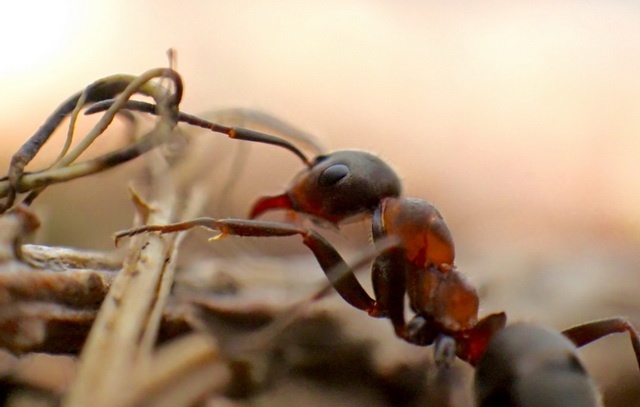Ants produce powerful antibiotic by mixing resin with acid
Workers of the wood ant Formica paralugubris are skilled poisoners. By treating tree resin with formic acid, they produce a powerful disinfectant to control a pathogenic fungus, Thimothée Brütsch and colleagues show.
Pathogenic micro-organisms, such as the common entomopathogenic fungus Metarhizium brunneum, pose a continuous threat to ant nests; because the ants live close together, the risk of epidemics is high. Therefore, ants should keep their nests hygienic.
Resin
And so they do. Workers of the alpine wood ant Formica paralugubris, for instance, incorporate large amounts of solidified resin from coniferous trees, especially spruce, into their nest to fight pathogens, as Michel Chapuisat showed. The distinctive smell of tree resin comes from terpenes and other volatile substances; these are compounds that decrease bacterial and fungal load in wounded trees. And within ant nests, they do as well. In the presence of resin, bacteria and fungi are inhibited, with the result that more larvae survive when exposed to Metarhizium, and adult ants and larvae have a higher chance to survive when a detrimental bacterium invades the nest.
Combination
Now, Thimothée Brütsch and colleagues report that the ants enhance the antifungal activity of the resin considerably by applying formic acid. This acid, which the ants produce into their venom gland, has an antiseptic effect in itself, just like the volatile substances from resin. But the mixture of the resin with formic acid seems to work particularly well; it has greater antifungal activity than you would expect from the separate effects of resin and acid. This means that the acid increases the disinfectant effect of the tree resin.
So, the ants not only collect pieces of resin to disinfect their nest and protect themselves against pathogens, but they also treat it with formic acid to obtain a more powerful antimicrobial agent.
Willy van Strien
Photo: © Timothée Brütsch
Sources:
Brütsch, T., G. Jaffuel, A. Vallat, T.C.J. Turlings & M. Chapuisat, 2017. Wood ants produce a potent antimicrobial agent by applying formic acid on tree-collected resin. Ecology and Evolution, online March 6. Doi: 10.1002/ece3.2834
Chapuisat, M., A. Oppliger, P. Magliano & P. Christe, 2007. Wood ants use resin to protect themselves against pathogens. Proceedings of the Royal Society B 274: 2013-2017. Doi: 10.1098/rspb.2007.0531
